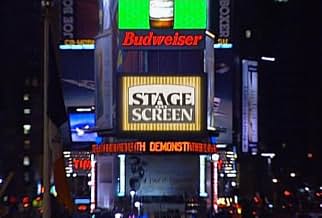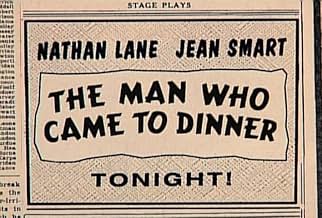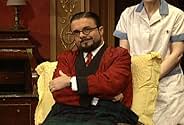अपनी भाषा में प्लॉट जोड़ेंCantankerous theatre critic Sheridan Whiteside falls on an icy sidewalk, breaks his hip, and is temporarily stranded at the Ohio home of Richard Stanley and his family. While he's there, Whi... सभी पढ़ेंCantankerous theatre critic Sheridan Whiteside falls on an icy sidewalk, breaks his hip, and is temporarily stranded at the Ohio home of Richard Stanley and his family. While he's there, Whiteside turns life upside-down for everyone.Cantankerous theatre critic Sheridan Whiteside falls on an icy sidewalk, breaks his hip, and is temporarily stranded at the Ohio home of Richard Stanley and his family. While he's there, Whiteside turns life upside-down for everyone.
- निर्देशक
- लेखक
- स्टार
Harriet Sansom Harris
- Maggie Cutler
- (as Harriet Harris)
Jeff Hayenga
- John
- (as Jeffrey Hayenga)
फ़ीचर्ड समीक्षाएं
The 1942 film THE MAN WHO CAME TO DINNER was possibly the best comedy film that Bette Davis ever appeared in, but while she got starring position in the film's credits, the real star (who went to town as a result) was the great Monty Woolley, recreating his magnificent acid tongued curmudgeon Sheridan Whiteside. It was one of the rare occasions when a stage performance of importance was saved on film.
Fifty eight years later (forgetting one disastrous television version with Orson Welles as Whiteside in 1972) PBS showed this production of the stage revival of the play with Nathan Lane in the Whiteside role. Lane played the role perfectly, basing it (physically) closer to the original figure Whiteside is based on - writer, critic, actor, radio personality, and Algonquin Round Table Wit Alexander Woolcott. His facial appearance included wearing the round eye frame glasses that Woolcott wore all the time. Lane did not have the crusty, elderly asperity of the great Woolley, but he did have a malevolent elfin charm reminiscent of Woolcott (a man who was all too easy to dislike - Woolcott was also the model for Waldo Lydecker in LAURA, which just goes to show his popularity).
One of the problems with comedy (or drama generally speaking) is the fact that the works can be dated in their references. When, in one of his plays, Shakespeare refers to "the Great Sophy" it is to some long ago forgotten English traveler and diplomat named Shirley who went to Persia. Most of us see the foot note of this 16th Century reference and try to concentrate on the rest of the play that still is strong and relevant to us. But with THE MAN WHO CAME TO DINNER the great problem is the barrage of trivia that comes out of the play. Woolcott's two Algonquin friends (Kaufman and Moss Hart) added small bits of biography to his stage version, which everyone who knew Woolcott would recognize. The theater critic knew everyone of importance in the theater. So he has a scene with a clone of Noel Coward named Beverley Carlton (to add to perfecting the imitation of Coward, Kaufman and Hart asked Cole Porter, a close friend of Monty Woolley, to write a song for "Carlton" to sing to Whiteside, that was in Coward's distinct delicate style). The close friend of Whiteside who shows up as a comic "deus ex ma china" in the play is "Banjo." This was based on Woolcott's close Algonquin friend Harpo Marx.
But most of the references are quite arcane. Who is Elizabeth Sedley? Well, it is a reference to a celebrated murder case defendant, whose career would have intrigued Woolcott, the great amateur criminologist. What are the references to Beebe and Byrd? This version got around the problems using mock 1930s newspaper headlines chronicling William Beebe the oceanographer and Admiral Richard Byrd, the Polar explorer. This sounds cumbersome, but it was far more effective and useful to the viewers than the idiocy of the 1972 Welles' version where the script was "up-dated" meaninglessly.
The program was an excellent version of the classic comedy, and well worth comparing with the Woolley film. I feel that it deserves a "10".
Fifty eight years later (forgetting one disastrous television version with Orson Welles as Whiteside in 1972) PBS showed this production of the stage revival of the play with Nathan Lane in the Whiteside role. Lane played the role perfectly, basing it (physically) closer to the original figure Whiteside is based on - writer, critic, actor, radio personality, and Algonquin Round Table Wit Alexander Woolcott. His facial appearance included wearing the round eye frame glasses that Woolcott wore all the time. Lane did not have the crusty, elderly asperity of the great Woolley, but he did have a malevolent elfin charm reminiscent of Woolcott (a man who was all too easy to dislike - Woolcott was also the model for Waldo Lydecker in LAURA, which just goes to show his popularity).
One of the problems with comedy (or drama generally speaking) is the fact that the works can be dated in their references. When, in one of his plays, Shakespeare refers to "the Great Sophy" it is to some long ago forgotten English traveler and diplomat named Shirley who went to Persia. Most of us see the foot note of this 16th Century reference and try to concentrate on the rest of the play that still is strong and relevant to us. But with THE MAN WHO CAME TO DINNER the great problem is the barrage of trivia that comes out of the play. Woolcott's two Algonquin friends (Kaufman and Moss Hart) added small bits of biography to his stage version, which everyone who knew Woolcott would recognize. The theater critic knew everyone of importance in the theater. So he has a scene with a clone of Noel Coward named Beverley Carlton (to add to perfecting the imitation of Coward, Kaufman and Hart asked Cole Porter, a close friend of Monty Woolley, to write a song for "Carlton" to sing to Whiteside, that was in Coward's distinct delicate style). The close friend of Whiteside who shows up as a comic "deus ex ma china" in the play is "Banjo." This was based on Woolcott's close Algonquin friend Harpo Marx.
But most of the references are quite arcane. Who is Elizabeth Sedley? Well, it is a reference to a celebrated murder case defendant, whose career would have intrigued Woolcott, the great amateur criminologist. What are the references to Beebe and Byrd? This version got around the problems using mock 1930s newspaper headlines chronicling William Beebe the oceanographer and Admiral Richard Byrd, the Polar explorer. This sounds cumbersome, but it was far more effective and useful to the viewers than the idiocy of the 1972 Welles' version where the script was "up-dated" meaninglessly.
The program was an excellent version of the classic comedy, and well worth comparing with the Woolley film. I feel that it deserves a "10".
If you're in a mood to laugh yourself silly, this is the play for you. Nathan Lane is at his scenery-chewing best as Sheridan Whiteside (modeled on Alexander Woolcott), a critic, commentator, and friend of the great and near-great who is forced to spend several weeks in the home of a Middle America family for whom "Goodbye Mister Chips" is as high on the cultural scale as they go. Lewis Stadlen is equally hilarious as the manic, irrepressible Banjo (a takeoff of one of the Marx Brothers, but I'm not sure which). Jean Smart is wonderful as the haughty and man-eating Lorraine Sheldon, and Harriet Harris is superb as Maggie Cutler, Whiteside's devoted secretary and Lorraine's nemesis.
To get all the references, you'll need a copy of Who Was Who in Theater, Film, and Opera, but I'm glad they didn't try to update them. It just wouldn't have worked.
Finally, kudos to Ryan Shively (as Sandy, union organizer and June's fiancee)! A talented actor and an all-around great guy (okay, he's my roommate, so I'm a little biased)!
To get all the references, you'll need a copy of Who Was Who in Theater, Film, and Opera, but I'm glad they didn't try to update them. It just wouldn't have worked.
Finally, kudos to Ryan Shively (as Sandy, union organizer and June's fiancee)! A talented actor and an all-around great guy (okay, he's my roommate, so I'm a little biased)!
'The Man Who Came To Dinner' revival was just absolutely amazing! The cast shined. Mr.Sheridan Whiteside was played by the one and only Nathan Lane, who made the play pleasurable the whole time. Jean Smart was, in my opinion, one of the funniest on stage. In a specific scene, when she finds out her cables have been wrongfully sent, she has the crowds (and folks at home) up in roars. This wonderful cast also includes Lewis Stadlen, Harriet Harris, Byron Jennings, Terry Beaver, and many more. If you are ever faced with the chance to see this play, don't pass on it! It Is A True Masterpiece!!
I gave this DVD version of the play a 10 simply for the scene stealing performance by Byron Jennings. He is truly amazing as Beverley Carlton. This is not to be missed by anyone who appreciates uncommonly gifted acting.
Nathan Lane as Sheridan Whiteside is the perfect foil for him. His line about the Lindbergh baby is hilarious, and Byron Jennings' reaction is well in tune with Nathan Lane's humor. It's rare to watch actors who are so much in sync with each other. Too often a film or play will feature great talent playing opposite mediocre talent. Speaking of which, the actress who plays Sheridan Whiteside's secretary is not of their caliber and detracts from their performance.
The play's greatest weakness is that Mr. Jennings appears in just one scene.
Still, it's amazing enough to be worth the cost of purchase.
It's so unfortunate that American film and theater productions place greater value on perfectly photogenic looks, rather than exceptional talent. If only film and theater goers were able to recognize and value substance and depth of character, they would be able to look beyond the shallowness and one dimensional "acting" that is foisted on us.
Nathan Lane as Sheridan Whiteside is the perfect foil for him. His line about the Lindbergh baby is hilarious, and Byron Jennings' reaction is well in tune with Nathan Lane's humor. It's rare to watch actors who are so much in sync with each other. Too often a film or play will feature great talent playing opposite mediocre talent. Speaking of which, the actress who plays Sheridan Whiteside's secretary is not of their caliber and detracts from their performance.
The play's greatest weakness is that Mr. Jennings appears in just one scene.
Still, it's amazing enough to be worth the cost of purchase.
It's so unfortunate that American film and theater productions place greater value on perfectly photogenic looks, rather than exceptional talent. If only film and theater goers were able to recognize and value substance and depth of character, they would be able to look beyond the shallowness and one dimensional "acting" that is foisted on us.
As someone who goes out of his way to see performances of "The Man Who Came to Dinner"--one of the greatest comic concoctions of the 20th century--I thought this was the best media presentation of the play to date, much better than the 1940 film version. My only quibble concerns the decision to pattern Lewis Stadlen's Banjo after Jimmy Durante's version in the film, rather than Harpo Marx (upon whom the character was originally modelled), but that's a matter of personal taste. (And to be fair, Stadlen does just fine, perhaps even out-Duranting Durante.) Conversely, I can't imagine anyone better in the title role than Nathan Lane, and he lives up to my hopes splendidly. (I hope PBS broadcasts him in "The Producers" one of these days!)
क्या आपको पता है
- ट्रिवियाThe part of Banjo was originally based on Alexander Woollcott's good friend, Harpo Marx. However, in this production, the character is blatantly patterned after Jimmy Durante, who played the role in the 1942 film adaptation.
- भाव
Sheridan Whiteside: I may vomit.
- कनेक्शनReferenced in My Boys: Free Agent (2006)
टॉप पसंद
रेटिंग देने के लिए साइन-इन करें और वैयक्तिकृत सुझावों के लिए वॉचलिस्ट करें
विवरण
- रिलीज़ की तारीख़
- कंट्री ऑफ़ ओरिजिन
- भाषा
- फ़िल्माने की जगहें
- न्यूयॉर्क शहर, न्यूयॉर्क, संयुक्त राज्य अमेरिका(American Airlines Theater)
- उत्पादन कंपनियां
- IMDbPro पर और कंपनी क्रेडिट देखें
इस पेज में योगदान दें
किसी बदलाव का सुझाव दें या अनुपलब्ध कॉन्टेंट जोड़ें






























